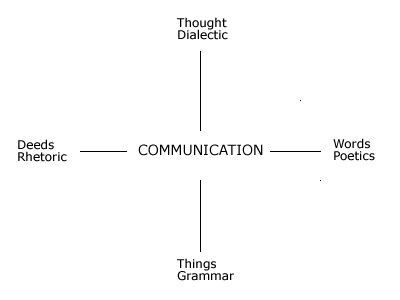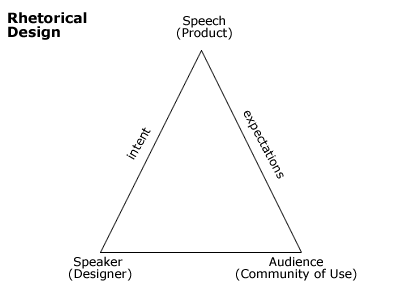|
Friday, November 14, 2003
Semiotics in Design
We read Roland Barthes' "Rhetoric of the Image," which employs a dialectic to explore grammar. In it, he tries to find the nature of meaning itself (Truth with a big T). He looks at two arguments: Images either have no meaning, or they are the limit of all meaning.Semiotics has grown into a powerful art in the 20th century. There are three main aspects of semiotics: - Semantics (the meaning of individual words)
- Syntactics (the rules of combinations of words)
- Pragmatics (the impact on an audience. i.e. rhetoric)
Semiotics is interested in the relationship between things, thoughts, and signs. There are three kinds of signs: - index (has a physical connection to the thing that it signifies (smoke from a cigarette))
- icon (has a relationship to what it signifies, but isn't physically connected (maps))
- symbol (totally conventional or arbitrary to signifier (words)
Barthes is interested in a message that doesn't need to be decoded, delivered through an image.
posted at 08:12 PM in
| comments (0)
| trackback (0)
| link
Grammatical Design
Dick noted that there are two ways to create anything: imagination (creating new forms through invention) or through fancy (fitting together existing forms). Grammatical design is concerned with the latter.Grammar is not like Rhetoric, which is all about invention. Grammatical design is concerned with interpretation and finding meaning. It is all about discovering the least elements, the smallest parts of communication (word and image), then adding the complicating element of rules to form not an argument (which would be rhetoric), but instead meaning and resonance. The model of grammar is another triangle, with thing, thought, and signs as its three points. As an example of grammatical thinking in design, we looked at Philip Meggs' book, Type and Image. The book begins with the basics of typography and images. Then each section successively adds complications, adding something new to the concept of Design. The pinnacle of Design for Meggs is resonance, the drawing on feelings and memories of the past.
posted at 08:01 PM in
design theory
| comments (1)
| trackback (0)
| link
Leave Those Kids Alone
Amusingly, my assistantship for spring semester is teaching a class: visual interface design, the undergraduate version of the class I'm in now, interface and interaction design. Should be very interesting.
posted at 07:35 PM in
assistantships
| comments (0)
| trackback (0)
| link
Philosophy and New Technology
Almost a stereotypical day today at CMU. I went to two special lectures. The first was given by John SanGiovanni, a Technical Evangelist for Microsoft in their Mobile Computing & Wireless Technologies unit. He showed off some new cool stuff happening with the tablet PC (interactive sketching canvasses, 3D sketches that you can instantly start to manipulate in space), trends in mobile computing (MS's Spot Network), and his own research into Xnav. Xnav is a gesturing system that replaces traditional keyboards and other input devices. Neema has a more detailed overview of it on his site. It was a neat idea, but its implementation still revolved around things like joysticks. I thought it was going to incorporate some sort of glove that fit on your non-dominant hand that you would then use by gesturing in a small way with your index finger or thumb. But still an interesting idea.The second lecture was by Eugene Garver, Regents Professor of Philosophy at St. John's University. The topic was philosophical ethos. He read a paper on books and philosophy: does philosophy mainly reside in books or is it rather in life/speech? Some interesting topics were raised. Garver put forth the notion that too much specialization makes one less of a citizen. As your knowledge gets specialized, you engage with less and less of the world and more with a smaller group of people who understand what you are talking about. While this might apply in academia, I'm not sure I believe it applies universally. As the world and its problems get more complex, we need specialists to solve them, not generalists (although I agree that generalists are also of importance). Arguably, the history of the world has been shaped by specialists in fields of art, science, politics, religion. Is the Dalai Lama not a great citizen because he is a specialist? Was Einstein? Lincoln? Another interesting topic was the idea of the US Constitution becoming, after the civil war, the language American's use to talk about justice. It provides now a type of base from which our concept of justice springs. We also talked about reading and writing, and how designers need to take care not to overly "de-skill" users, lest they lose their humanity.
posted at 07:20 PM in
special guest stars
| comments (0)
| trackback (0)
| link
CMU Wireless Use Map
I've never seen this map of real-time CMU wireless users before, but it's really cool.
posted at 04:31 PM in
cmu
| comments (2)
| trackback (0)
| link
Thursday, November 13, 2003
Methods of Invention Readings
Two readings about invention in design:- "A Defense of Nonsense" by G.K. Chesterton from The Defendant
- "Wicked Problems in Design Thinking" by Dick Buchanan from The Idea of Design
posted at 09:12 AM in
readings
| comments (0)
| trackback (0)
| link
Form Paper
Lest you think that all we do are projects in Design school, I can tell you we occasionally write things as well. I spent a ridiculous amount of time writing this three-page paper on form (pdf 28k) for Seminar class.
posted at 08:58 AM in
papers
| comments (3)
| trackback (0)
| link
USC Announces Game Design Minor
CMU dropped the ball on this one. My old undergrad rival school, USC, just announced they're creating a minor in Game Design. The fact it is not a major speaks volumes about how slow academia is to catch on to new industries. CMU could redeem itself by making a game design major as part of the ETC.
posted at 08:31 AM in
cmu
| comments (0)
| trackback (0)
| link
Monday, November 10, 2003
Rhetoric and Poetics in Design
We started applying the four essential arts to design today, starting with Rhetoric and Poetics.Communication and interaction are closely related in our work. Depending on what interpretation of interaction design you're using, to interact is to communicate or to communicate is to interact. So this diagram springs from putting communication at the center of design: 
Poetics is the art of creating complete, emotionally satisfying experiences. The poetics of a work of art is its completeness. Rhetoric is the art of persuasion through invention. It is not manipulation; it persuades by inventing arguments, arguments that the audience uses to draw their own conclusions. Rhetoric is not the decoration of messages, but the creation of arguments. Products are arguments about how we should live our lives. 
Products have three characteristics: Ethos, the voice of the product, or its desirability; Pathos, which addresses the values and expectations (physical, cognitive, and cultural) of the audience--its affordances and adumbrations; and Logos, the technological reasoning, or how the product works. We are persuaded by all three aspects, sometimes one more than the others, sometimes all in balance. Designing rhetorically is a radical method because in this model, there are no fixed truths or things. These exist only in the beliefs of the speaker and the audience. This model doesn't deny Truth; it is just held within the communication between people. Echoes of the existentialist interpretation.
posted at 10:12 PM in
design theory
| comments (2)
| trackback (0)
| link
Grammar and Dialectic Readings
Continuing the exploration between the traditional arts and design, two more readings:
posted at 05:15 PM in
readings
| comments (0)
| trackback (0)
| link
Sunday, November 9, 2003
Aloha from Pittsburgh
When CPID classmate Cheryl Gach planned a luau a few days ago, it was 78 degrees. Last night, the night of the luau, it was 28 degrees. Perfect for Hawaiian shirts and grass skirts! Still, a good time--and fruity rum beverages--were enjoyed by all.
posted at 10:58 AM in
extracurricular
| comments (0)
| trackback (0)
| link
‹‹ preceding entries
|

